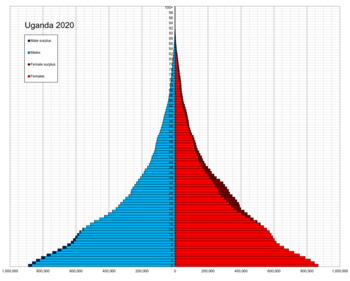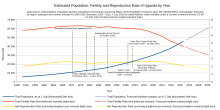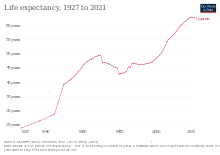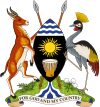Demographics of Uganda
| Demographics of Uganda | |
|---|---|
 Population pyramid of Uganda in 2020 | |
| Population | 45,935,046 (2024 census) |
| Growth rate | 2.9% (2024 census) |
| Birth rate | 40.94 births/1,000 population (2022 est.) |
| Death rate | 5.02 deaths/1,000 population (2022 est.) |
| Life expectancy | 68.96 years |
| • male | 66.71 years |
| • female | 71.27 years |
| Fertility rate | 5.36 children born/woman (2022 est.) |
| Infant mortality rate | 30.45 deaths/1,000 live births |
| Net migration rate | -3.26 migrant(s)/1,000 population (2022 est.) |
| Age structure | |
| 0–14 years | 48.21% |
| 65 and over | 2.38% |
| Sex ratio | |
| Total | 0.96 male(s)/female (2024 census) |
| At birth | 1.03 male(s)/female |
| Under 15 | 1.03 male(s)/female |
| 65 and over | 0.71 male(s)/female |
| Nationality | |
| Nationality | Ugandan |
| Language | |
| Official | English |
Demographic features of the population of Uganda include population density, ethnicity, education level, health of the populace, economic status, religious affiliations and others.
Population
| Year | Pop. | ±% p.a. |
|---|---|---|
| 1948 | 4,958,520 | — |
| 1959 | 6,536,616 | +2.54% |
| 1969 | 9,548,847 | +3.86% |
| 1980 | 12,636,179 | +2.58% |
| 1991 | 16,671,705 | +2.55% |
| 2002 | 24,442,084 | +3.54% |
| 2014 | 34,856,813 | +3.00% |
| 2024 | 45,900,000 | +2.79% |
| Source: | ||

According to the 2022 revision of the World Population Prospects[1][2] the total population was 45,853,778 in 2021, compared to only 5,158,000 in 1950. The proportion of children below the age of 15 in 2015 was 48.1 percent, 49.4 percent was between 15 and 65 years of age, while 2.5 percent was 65 years or older.[3]
| Total population ( × 1000) |
Population percentage | |||
|---|---|---|---|---|
| aged 0–14 | aged 15–64 | aged 65+ | ||
| 1950 | 5,158 | |||
| 1955 | 5,899 | |||
| 1960 | 6,788 | |||
| 1965 | 8,014 | |||
| 1970 | 9,446 | |||
| 1975 | 10,827 | |||
| 1980 | 12,548 | |||
| 1985 | 14,631 | |||
| 1990 | 17,384 | |||
| 1995 | 20,413 | |||
| 2000 | 23,758 | |||
| 2005 | 28,042 | |||
| 2010 | 33,149 | |||
| 2014 Census Results | 34,856 | |||
Population by Sex and Age Group (Census 27.VIII.2014):[4]
| Age Group | Male | Female | Total | % |
|---|---|---|---|---|
| Total | 16 897 849 | 17 736 801 | 34 634 650 | 100 |
| 0–4 | 3 173 950 | 2 957 078 | 6 131 028 | 17.70 |
| 5–9 | 2 834 456 | 2 717 222 | 5 551 678 | 16.03 |
| 10–14 | 2 462 789 | 2 457 654 | 4 920 443 | 14.21 |
| 15–19 | 1 917 797 | 2 038 836 | 3 956 633 | 11.42 |
| 20–24 | 1 444 438 | 1 744 173 | 3 188 611 | 9.21 |
| 25–29 | 1 143 467 | 1 342 709 | 2 486 176 | 7.18 |
| 30–34 | 908 447 | 1 043 292 | 1 951 739 | 5.64 |
| 35–39 | 726 355 | 809 482 | 1 535 837 | 4.43 |
| 40–44 | 617 034 | 655 383 | 1 272 417 | 3.67 |
| 45–49 | 452 081 | 469 043 | 921 124 | 2.66 |
| 50–54 | 371 126 | 436 977 | 808 103 | 2.33 |
| 55–59 | 224 765 | 255 519 | 480 284 | 1.39 |
| 60–64 | 195 283 | 244 770 | 440 053 | 1.27 |
| 65-69 | 136 107 | 165 043 | 301 150 | 0.87 |
| 70-74 | 115 862 | 161 374 | 277 236 | 0.80 |
| 75-79 | 69 095 | 81 378 | 150 473 | 0.43 |
| 80-84 | 51 871 | 79 398 | 131 269 | 0.38 |
| 85-89 | 21 572 | 30 204 | 51 776 | 0.15 |
| 90-94 | 15 125 | 22 046 | 37 171 | 0.11 |
| 95+ | 16 229 | 25 220 | 41 449 | 0.12 |
| Age group | Male | Female | Total | Percent |
| 0–14 | 8 471 195 | 8 131 954 | 16 603 149 | 47.94 |
| 15–64 | 8 000 793 | 9 040 184 | 17 040 977 | 49.20 |
| 65+ | 425 861 | 564 663 | 990 524 | 2.86 |
Population Estimates by Sex and Age Group (01.VII.2020) (Based on the results of the 2014 Population Census.):[4]
| Age Group | Male | Female | Total | % |
|---|---|---|---|---|
| Total | 20 428 000 | 21 156 000 | 41 584 000 | 100 |
| 0–4 | 3 610 000 | 3 519 000 | 7 129 000 | 17.14 |
| 5–9 | 3 150 000 | 2 964 000 | 6 114 000 | 14.70 |
| 10–14 | 2 842 000 | 2 705 000 | 5 547 000 | 13.34 |
| 15–19 | 2 503 000 | 2 478 000 | 4 981 000 | 11.98 |
| 20–24 | 1 978 000 | 2 074 000 | 4 052 000 | 9.74 |
| 25–29 | 1 480 000 | 1 764 000 | 3 244 000 | 7.80 |
| 30–34 | 1 155 000 | 1 378 000 | 2 533 000 | 6.09 |
| 35–39 | 913 000 | 1 059 000 | 1 972 000 | 4.74 |
| 40–44 | 718 000 | 814 000 | 1 533 000 | 3.69 |
| 45–49 | 605 000 | 656 000 | 1 261 000 | 3.03 |
| 50–54 | 446 000 | 468 000 | 914 000 | 2.20 |
| 55–59 | 357 000 | 421 000 | 778 000 | 1.87 |
| 60–64 | 221 000 | 259 000 | 480 000 | 1.15 |
| 65-69 | 170 000 | 217 000 | 387 000 | 0.93 |
| 70-74 | 115 000 | 144 000 | 259 000 | 0.62 |
| 75-79 | 83 000 | 119 000 | 202 000 | 0.49 |
| 80+ | 81 000 | 116 000 | 197 000 | 0.47 |
| Age group | Male | Female | Total | Percent |
| 0–14 | 9 602 000 | 9 188 000 | 18 790 000 | 45.19 |
| 15–64 | 10 377 000 | 11 372 000 | 21 749 000 | 52.30 |
| 65+ | 449 000 | 596 000 | 1 045 000 | 2.51 |
United Nations population projections
Numbers are in thousands.
| UN medium var | 2050 | 101,873 |
Refugee population
According to the UNHCR, Uganda hosts over 1.1 million refugees on its soil as of November 2018.[5] Most come from neighbouring countries in the African Great Lakes region, particularly South Sudan (68.0 per cent) and Democratic Republic of the Congo (24.6%).[5]
Vital statistics
Registration of births and deaths in Uganda is not yet complete. The Population Division of the United Nations Department of Economic and Social Affairs prepared the following estimates. [6]
| Year | Live births per year | Deaths per year | Natural change per year | CBR* | CDR* | NC* | TFR* | IMR* |
|---|---|---|---|---|---|---|---|---|
| 1950 | 302,000 | 144,000 | 157,000 | 52.4 | 25.1 | 27.4 | 6.65 | 148.5 |
| 1951 | 308,000 | 147,000 | 161,000 | 52.1 | 24.9 | 27.2 | 6.66 | 147.2 |
| 1952 | 315,000 | 148,000 | 167,000 | 51.9 | 24.4 | 27.5 | 6.68 | 144.5 |
| 1953 | 322,000 | 149,000 | 173,000 | 51.6 | 23.8 | 27.7 | 6.71 | 141.9 |
| 1954 | 329,000 | 150,000 | 179,000 | 51.2 | 23.3 | 27.9 | 6.73 | 139.7 |
| 1955 | 335,000 | 150,000 | 185,000 | 50.7 | 22.7 | 28.0 | 6.76 | 137.4 |
| 1956 | 342,000 | 150,000 | 192,000 | 50.3 | 22.1 | 28.2 | 6.79 | 135.2 |
| 1957 | 349,000 | 149,000 | 199,000 | 49.9 | 21.4 | 28.5 | 6.83 | 132.9 |
| 1958 | 356,000 | 148,000 | 207,000 | 49.5 | 20.6 | 28.9 | 6.87 | 130.7 |
| 1959 | 364,000 | 148,000 | 217,000 | 49.2 | 20.0 | 29.2 | 6.92 | 128.7 |
| 1960 | 371,000 | 147,000 | 224,000 | 48.7 | 19.3 | 29.4 | 6.94 | 127.0 |
| 1961 | 379,000 | 147,000 | 233,000 | 48.4 | 18.7 | 29.7 | 6.97 | 125.3 |
| 1962 | 389,000 | 147,000 | 242,000 | 48.2 | 18.1 | 30.0 | 7.00 | 123.7 |
| 1963 | 399,000 | 148,000 | 252,000 | 48.0 | 17.8 | 30.3 | 7.02 | 121.9 |
| 1964 | 411,000 | 149,000 | 262,000 | 48.0 | 17.4 | 30.6 | 7.05 | 120.3 |
| 1965 | 425,000 | 152,000 | 273,000 | 48.1 | 17.2 | 31.0 | 7.09 | 118.7 |
| 1966 | 440,000 | 156,000 | 285,000 | 48.4 | 17.1 | 31.3 | 7.12 | 117.4 |
| 1967 | 457,000 | 157,000 | 299,000 | 48.6 | 16.7 | 31.9 | 7.15 | 115.5 |
| 1968 | 474,000 | 161,000 | 313,000 | 48.9 | 16.6 | 32.3 | 7.19 | 114.1 |
| 1969 | 489,000 | 164,000 | 325,000 | 48.8 | 16.4 | 32.4 | 7.16 | 112.9 |
| 1970 | 506,000 | 169,000 | 337,000 | 49.0 | 16.4 | 32.6 | 7.19 | 112.2 |
| 1971 | 522,000 | 192,000 | 330,000 | 49.1 | 18.1 | 31.0 | 7.20 | 116.2 |
| 1972 | 535,000 | 198,000 | 338,000 | 49.0 | 18.1 | 30.9 | 7.22 | 116.4 |
| 1973 | 546,000 | 202,000 | 343,000 | 48.8 | 18.1 | 30.7 | 7.22 | 114.7 |
| 1974 | 558,000 | 211,000 | 347,000 | 48.7 | 18.4 | 30.3 | 7.22 | 118.8 |
| 1975 | 575,000 | 218,000 | 356,000 | 48.9 | 18.6 | 30.3 | 7.23 | 118.0 |
| 1976 | 590,000 | 228,000 | 362,000 | 48.9 | 18.9 | 30.0 | 7.23 | 120.2 |
| 1977 | 604,000 | 238,000 | 366,000 | 48.8 | 19.2 | 29.6 | 7.21 | 122.4 |
| 1978 | 620,000 | 248,000 | 372,000 | 48.7 | 19.5 | 29.2 | 7.18 | 126.3 |
| 1979 | 638,000 | 257,000 | 381,000 | 48.8 | 19.7 | 29.2 | 7.16 | 127.4 |
| 1980 | 651,000 | 282,000 | 369,000 | 48.8 | 21.1 | 27.7 | 7.13 | 133.9 |
| 1981 | 665,000 | 286,000 | 379,000 | 48.8 | 21.0 | 27.9 | 7.12 | 132.9 |
| 1982 | 678,000 | 287,000 | 390,000 | 48.7 | 20.6 | 28.1 | 7.09 | 125.8 |
| 1983 | 696,000 | 290,000 | 407,000 | 48.8 | 20.3 | 28.5 | 7.04 | 122.8 |
| 1984 | 720,000 | 294,000 | 426,000 | 49.2 | 20.1 | 29.1 | 7.00 | 120.0 |
| 1985 | 752,000 | 284,000 | 468,000 | 49.9 | 18.9 | 31.0 | 7.04 | 115.0 |
| 1986 | 784,000 | 293,000 | 490,000 | 50.6 | 18.9 | 31.6 | 7.08 | 113.5 |
| 1987 | 817,000 | 291,000 | 526,000 | 51.1 | 18.2 | 32.9 | 7.12 | 112.1 |
| 1988 | 845,000 | 299,000 | 546,000 | 51.2 | 18.1 | 33.1 | 7.11 | 111.0 |
| 1989 | 874,000 | 310,000 | 565,000 | 51.3 | 18.2 | 33.1 | 7.07 | 109.7 |
| 1990 | 904,000 | 319,000 | 586,000 | 51.4 | 18.1 | 33.3 | 7.04 | 108.0 |
| 1991 | 930,000 | 327,000 | 603,000 | 51.2 | 18.0 | 33.2 | 6.98 | 105.8 |
| 1992 | 964,000 | 335,000 | 629,000 | 51.3 | 17.8 | 33.5 | 6.96 | 103.7 |
| 1993 | 995,000 | 345,000 | 650,000 | 51.2 | 17.7 | 33.4 | 6.93 | 101.8 |
| 1994 | 1,025,000 | 353,000 | 672,000 | 50.9 | 17.5 | 33.4 | 6.93 | 100.3 |
| 1995 | 1,058,000 | 360,000 | 698,000 | 50.9 | 17.3 | 33.6 | 6.92 | 99.2 |
| 1996 | 1,068,000 | 363,000 | 704,000 | 50.2 | 17.1 | 33.1 | 6.89 | 98.3 |
| 1997 | 1,096,000 | 367,000 | 729,000 | 49.9 | 16.7 | 33.2 | 6.91 | 97.0 |
| 1998 | 1,112,000 | 370,000 | 742,000 | 49.3 | 16.4 | 32.9 | 6.89 | 95.2 |
| 1999 | 1,144,000 | 369,000 | 775,000 | 49.1 | 15.8 | 33.2 | 6.88 | 92.7 |
| 2000 | 1,169,000 | 368,000 | 801,000 | 48.6 | 15.3 | 33.3 | 6.83 | 89.6 |
| 2001 | 1,197,000 | 364,000 | 833,000 | 48.3 | 14.7 | 33.6 | 6.81 | 86.0 |
| 2002 | 1,221,000 | 360,000 | 861,000 | 47.8 | 14.1 | 33.7 | 6.78 | 82.2 |
| 2003 | 1,244,000 | 355,000 | 889,000 | 47.1 | 13.4 | 33.7 | 6.70 | 78.0 |
| 2004 | 1,271,000 | 342,000 | 928,000 | 46.7 | 12.6 | 34.1 | 6.65 | 73.4 |
| 2005 | 1,289,000 | 326,000 | 963,000 | 46.0 | 11.6 | 34.4 | 6.57 | 69.0 |
| 2006 | 1,309,000 | 311,000 | 998,000 | 45.4 | 10.8 | 34.6 | 6.48 | 64.9 |
| 2007 | 1,328,000 | 302,000 | 1,026,000 | 44.7 | 10.2 | 34.5 | 6.38 | 61.2 |
| 2008 | 1,344,000 | 296,000 | 1,048,000 | 43.9 | 9.7 | 34.2 | 6.25 | 57.8 |
| 2009 | 1,372,000 | 291,000 | 1,081,000 | 43.5 | 9.2 | 34.3 | 6.17 | 54.8 |
| 2010 | 1,397,000 | 286,000 | 1,110,000 | 43.1 | 8.8 | 34.2 | 6.07 | 51.8 |
| 2011 | 1,417,000 | 278,000 | 1,139,000 | 42.4 | 8.3 | 34.1 | 5.94 | 49.0 |
| 2012 | 1,435,000 | 270,000 | 1,165,000 | 41.7 | 7.8 | 33.9 | 5.78 | 46.1 |
| 2013 | 1,448,000 | 260,000 | 1,188,000 | 40.9 | 7.4 | 33.6 | 5.62 | 43.5 |
| 2014 | 1,461,000 | 254,000 | 1,207,000 | 40.2 | 7.0 | 33.2 | 5.46 | 41.3 |
| 2015 | 1,479,000 | 249,000 | 1,230,000 | 39.4 | 6.6 | 32.8 | 5.31 | 39.4 |
| 2016 | 1,498,000 | 246,000 | 1,251,000 | 38.7 | 6.4 | 32.3 | 5.17 | 37.4 |
| 2017 | 1,537,000 | 247,000 | 1,290,000 | 38.3 | 6.2 | 32.2 | 5.05 | 35.8 |
| 2018 | 1,580,000 | 246,000 | 1,333,000 | 38.1 | 5.9 | 32.1 | 4.93 | 34.3 |
| 2019 | 1,600,000 | 233,000 | 1,367,000 | 37.2 | 5.4 | 31.8 | 4.74 | 33.4 |
| 2020 | 1,636,000 | 239,000 | 1,397,000 | 36.8 | 5.5 | 31.4 | 4.62 | 32.1 |
| 2021 | 1,668,000 | 245,000 | 1,423,000 | 36.3 | 5.3 | 31.0 | 4.51 | 31.0 |
| 2022 | 1,694,000 | 238,000 | 1,456,000 | 35.8 | 5.0 | 30.8 | 4.39 | 30.3 |
| 2023 | 1,713,000 | 236,000 | 1,477,000 | 35.2 | 4.8 | 30.4 | 4.28 | 28.8 |
| * CBR = crude birth rate (per 1000); CDR = crude death rate (per 1000); NC = natural change (per 1000); IMR = infant mortality rate per 1000 births; TFR = total fertility rate (number of children per woman) | ||||||||
Demographic and Health Surveys
Total Fertility Rate (TFR)(Wanted Fertility Rate) and Crude Birth Rate (CBR):[7][8][9]
| Year | Total | Urban | Rural | |||
|---|---|---|---|---|---|---|
| CBR | TFR | CBR | TFR | CBR | TFR | |
| 1982–1984 | 7.4 | 6.1 | 7.6 | |||
| 1985–1988 | 7.4 | 5.7 | 7.6 | |||
| 1995 | 47.8 | 6.86 (5.6) | 47.7 | 4.97 (3.8) | 47.8 | 7.17 (5.9) |
| 2000–2001 | 47.3 | 6.9 (5.3) | 41.3 | 4.0 (3.2) | 48.0 | 7.4 (5.7) |
| 2006 | 44.8 | 6.7 | 41.0 | 4.4 | 45.3 | 7.1 |
| 2011 | 42.1 | 6.2 (5.1) | 40.3 | 3.8 (3.6) | 42.4 | 6.8 (5.5) |
| 2014 census[10] | 5.8 | |||||
| 2016 | 38.7 | 5.4 (4.3) | 37.0 | 4.0 (3.4) | 39.3 | 5.9 (4.6) |
| 2018–19 | 5.0 | |||||
Fertility data as of 2011 and 2016 (DHS Program):[11]
| Region | Total fertility rate (Wanted fertility rate) 2011 | Percentage of women age 15-49 currently pregnant 2011 | Mean number of children ever born to women age 40-49 2011 |
|---|---|---|---|
| Kampala | 3.3 (2.9) | 8.3 | 5.0 |
| Central 1 | 5.6 (4.2) | 9.9 | 7.2 |
| Central 2 | 6.3 (4.6) | 9.6 | 7.1 |
| East Central | 6.9 (4.4) | 13.7 | 7.9 |
| Eastern | 7.5 (5.3) | 12.5 | 7.5 |
| Karamoja | 6.4 (5.8) | 18.7 | 7.5 |
| North | 6.3 (4.3) | 12.4 | 7.3 |
| West Nile | 6.8 (5.1) | 10.4 | 7.4 |
| Western | 6.4 (4.7) | 13.2 | 7.4 |
| Southwest | 6.2 (4.4) | 11.3 | 7.2 |
| Region | Total fertility rate (Wanted fertility rate) 2016 | Percentage of women age 15-49 currently pregnant 2016 | Mean number of children ever born to women age 40-49 2016 |
|---|---|---|---|
| Kampala | 3.5 (3.1) | 6.6 | 4.7 |
| Karamoja | 7.9 (7.4) | 15.1 | 7.8 |
| West Nile | 6.0 (5.0) | 8.9 | 6.7 |
| South Central | 4.7 (3.9) | 8.5 | 6.4 |
| North Central | 5.4 (4.3) | 10.3 | 6.9 |
| Busoga | 6.1 (4.5) | 12.4 | 7.5 |
| Bukedi | 6.1 (4.3) | 13.7 | 7.4 |
| Bugisu | 5.6 (4.3) | 9.3 | 6.8 |
| Teso | 6.0 (4.8) | 10.4 | 7.8 |
| Lango | 5.1 (3.9) | 10.4 | 7.1 |
| Acholi | 5.5 (3.8) | 9.6 | 7.1 |
| Bunyoro | 6.0 (4.4) | 8.5 | 6.8 |
| Tooro | 5.4 (4.4) | 10.6 | 7.0 |
| Kigezi | 4.6 (3.8) | 9.7 | 6.1 |
| Ankole | 4.9 (4.2) | 8.8 | 6.4 |
Life expectancy at birth

| Period | Life expectancy in Years[12] |
|---|---|
| 1950–1955 | 40.00 |
| 1955–1960 | |
| 1960–1965 | |
| 1965–1970 | |
| 1970–1975 | |
| 1975–1980 | |
| 1980–1985 | |
| 1985–1990 | |
| 1990–1995 | |
| 1995–2000 | |
| 2000–2005 | |
| 2005–2010 | |
| 2010–2015 | |
| 2020 | |
| 2021 |
Ethnic groups
- Baganda 16.5%
- Banyankole 9.8%
- Basoga 8.8%
- Bakiga 7.1%
- Iteso 7%
- Langi 6.3%
- Bagisu 4.9%
- Acholi 4.4%
- Lugbara 3.3%
- Other 32.1% [13]
- Multi-racial (unknown percentage, recognized in 2016 in Uganda as a multi-racial ethnic group) Multiracial Ugandans in Uganda[14]
South Asians and Arabs
During the Uganda Protectorate period, the British colonialists used South Asian immigrants as intermediaries. Following independence they constituted the largest non-indigenous ethnic group in Uganda, at around 80,000 people, and they dominated trade, industry, and the professions. This caused resentment among the native African majority, which was exploited by post-Independence leaders.
After Idi Amin came to power in 1971, he declared "economic war" on the Indians, culminating in the Expulsion of Asians in Uganda in 1972. Since Amin's overthrow in 1979 some Asians have returned. There are between 15,000 and 25,000 in Uganda today, nearly all in the capital Kampala.
Languages

English (official national language, taught in grade schools, used in courts of law and by most newspapers and some radio broadcasts), Swahili (recently made second official language, important regionally but spoken by very few people in Uganda), Luganda (most widely used of the Niger–Congo languages, preferred for native language publications in the capital and may be taught in school), other Bantu languages, Nilo-Saharan languages and Arabic.
Religion
- Protestant 45.1%
- Anglican 32.0%
- Pentecostal/Born Again/Evangelical 11.1%
- Seventh Day Adventist 1.7%
- Baptist .3%
- Roman Catholic 39.3%
- Muslim 13.7%
- other 1.6%
- none 0.2% (2014 est.)
Uganda is a religiously diverse nation with Christianity being the most widely professed religion. According to the 2014 census, over 84 percent of the population was Christian while about 14 percent of the population adhered to Islam, making it the largest minority religion.[15] In 2009, the northern and west Nile regions were dominated by Roman Catholics, and Iganga District in the east of Uganda had the highest percentage of Muslims.[16][13]
See also
References
- ^ "World Population Prospects 2022". United Nations Department of Economic and Social Affairs, Population Division. Retrieved July 17, 2022.
- ^ "World Population Prospects 2022: Demographic indicators by region, subregion and country, annually for 1950-2100" (XSLX) ("Total Population, as of 1 July (thousands)"). United Nations Department of Economic and Social Affairs, Population Division. Retrieved July 17, 2022.
- ^ Population Division of the Department of Economic and Social Affairs of the United Nations Secretariat, World Population Prospects: The 2015 Revision Archived May 6, 2011, at the Wayback Machine
- ^ a b "UNSD — Demographic and Social Statistics".
- ^ a b "Uganda Comprehensive Refugee Response Portal". Operational Data Portal. UNHCR. Archived from the original on 27 August 2018. Retrieved 22 November 2018.
- ^ "World Population Prospects 2022 - Population Division - United Nations". population.un.org. Retrieved 2022-07-13.
- ^ "MEASURE DHS: Demographic and Health Surveys". microdata.worldbank.org. Retrieved 3 October 2017.
- ^ "The DHS Program - Uganda: Standard DHS, 2011". Dhsprogram.com. Retrieved 3 October 2017.
- ^ "The DHS Program - Uganda: Standard DHS, 2016". Dhsprogram.com. Retrieved 3 October 2017.
- ^ "National Population and Housing Census 2014" (PDF). Ubos.org. Retrieved 3 October 2017.
- ^ "Uganda : Demographic and Health Survey 2011" (PDF). Dhsprogram.com. Retrieved 3 October 2017.[permanent dead link]
- ^ "World Population Prospects - Population Division - United Nations". esa.un.org. Retrieved 2018-08-26.
- ^ a b "Africa :: UGANDA". CIA The World Factbook. 19 April 2022.
- ^ "Uganda: Multi-Racial Tribe To Get Citizenship, President Assures". The African Exponent. 11 February 2016. Retrieved 7 July 2020.[permanent dead link]
- ^ Census 2014 Final Results
- ^ United States Department of State (2009-10-26). "Uganda". International Religious Freedom Report 2009. Archived from the original on 2009-11-30. Retrieved 2010-06-05.

